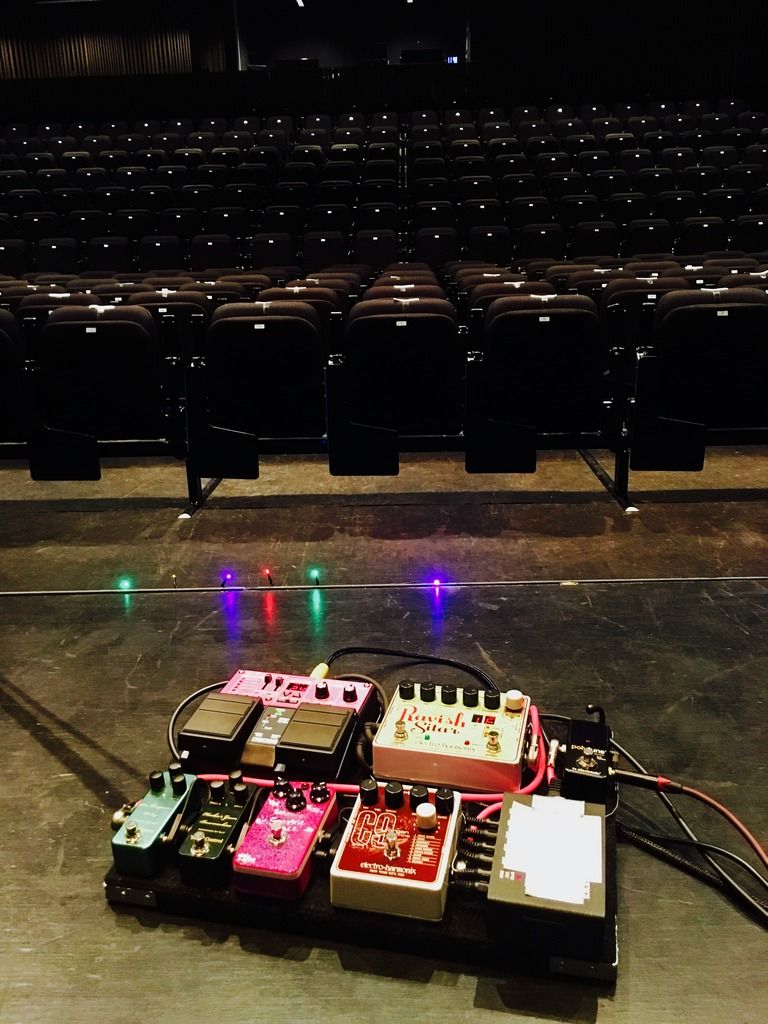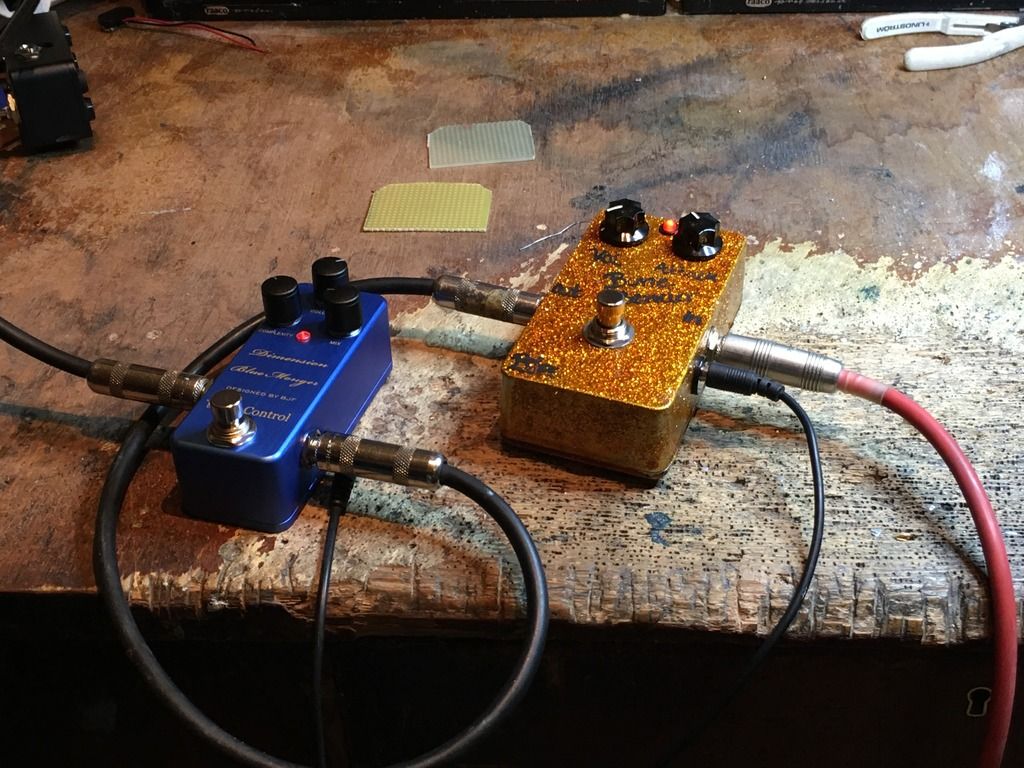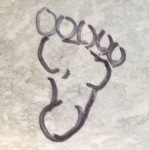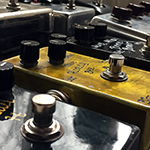Sorry for the radio silence. I had a chance to run the Bone Bender at rehearsals. It has a ton of output and I was not able to get the volume knob above 3 on the dial. It is a tricky situation, as I have to play somewhat low volume to back the musical and a lot of parts are changing on the fly.
On to the pedal. From what I understand it is based around a Tonebender MK I circuit. It is not as warm sounding as some other MK I builds I have but it still has that searing treble tone I associate with MK I tone. Also, on the note decay, some of the vintage MK I units I have played have these sort of artifacts on the note decay, kind of a crispy static noise for lack of a better description as the notes fade off. The Bone Bender does not have that. In my opinion it is in the updated version camp of the circuit. There is great string definition, small hammer on notes were readily heard and dead quiet at idle. There are not crispy edges on the notes like a vintage unit has.
The way it is now, I would place it in the MK I/MK II camp/ I would like to see a bit looser or warmer in the feel and more lo-fi sounding if that makes sense and still have that over the top output. For me, I like the crispy edges on the notes that come from the MK I tone. I was not able to work the pedal to extreme settings due to volume restrictions but once I get into a practice room I want to let it cook. I hope that makes sense. I have been running around busy the past couple of weeks and performance time is next week.
Great updated version of the circuit with modern conveniences, power adapter, LED, small foot print. It is more hi-fi sounding, very tight and focused, than I was expecting but that may be due to the updated construction techniques and circuit refinement, and not a 60's wiring scheme.
>>> Sparkle Face Research Project <<<
Moderator: Moderators
Re: >>> Sparkle Face Research Project <<<
Came up with this layout tonight for the sparkle face
https://www.dropbox.com/s/6su912evdl12k60/aviary-image-1481934891914.jpeg?dl=0/
Will try it this week if I get some of 2n1308 in time, if not I'll try with some 2n1306 that I have. I wasn't sure if you would want this posted, if not please delete.
https://www.dropbox.com/s/6su912evdl12k60/aviary-image-1481934891914.jpeg?dl=0/
Will try it this week if I get some of 2n1308 in time, if not I'll try with some 2n1306 that I have. I wasn't sure if you would want this posted, if not please delete.
- Baggy
- Posts: 28
- Joined: Fri Oct 28, 2016 8:44 am
- Guitars:: Fender 72 Telecaster Thinline reissue 2002, Gibson Flying v 2016 T, Gibson Les Paul Custom Classic lite 2016.
- amps: Vox AC4C1
- pedals: 2
Re: >>> Sparkle Face Research Project <<<
Hi there,
Thank you Baggy for the layout.
2N1306's will do just fine and are very similar to 2N1308's and for those interested in listening to and comparing transistors you can also add sockets.
Have fun
BJ
Thank you Baggy for the layout.
2N1306's will do just fine and are very similar to 2N1308's and for those interested in listening to and comparing transistors you can also add sockets.
Have fun
BJ
-

BJF - Posts: 522
- Joined: Tue Feb 27, 2007 4:43 am
- Location: Stockholm
- Guitars:: Les Pauls, V with P-90's and humbuckers, strats,tele duo-jet and expanding; pick ups mostly Lundgren or BJF/ Lundgren
Danelectro Barython - amps: MP CS-40, MP101, Hiwatt Custom 200, Hiwatt Custom 100, VOX AC15
Fender Blues De Ville, Fender Super Reverb, Marshall 5150 through various speakers - pedals: 42
Re: >>> Sparkle Face Research Project <<<
Hi there,
Yes, there will be a DIY Bone Bender, while for now I am currently waiting on parts to build some and define the circuit and also there will be a little tour through the circuit and a bit of history.
For the Sparkle Face and Bone Bender research projects I have taken the approach of setting bias so that transition from seemingly clean to distortion is gradual and symmetric, which in use means sounds can be set for near clean to full fuzz and gradually so with as low as possible static noises in the decay of a note.
The idea is to make a close to linear amplifier circuit that would overload symmetrically and gradually- that’d be a behavior you more expect from a tube amplifier than a fuzz pedal, but then back in the dawn of fuzzdom one of the things musicians wanted replicated with a fuzz pedal was an overdriven amplifier.
Now, back in the 1970’s there were theories of getting the tube amp response with germanium diodes and that due to the bended transfer curve that in a small segment could be likened to the transfer curve of a triode.
Indeed as the amplification is formed by the development of current through the emitter diode, germanium transistors would be able to get close and further since the bandwidth of germanium transistors is low and the raw gain is fairly low ( as compared to silicon transistors), the power bandwidth at full square output would result in slightly softened corners and that symmetrically to a square wave - much like suggested in the 1970’s the most desirable distortion of tube amplifiers would be: and thus a tube sound was suggested to be a square wave with rounded symmetrical edges and further to be dynamically controlled.
Oh yes I have seen this in some tube amps and most of the early tweed amps would do this: and thus transform from seemingly clean to square output with gently rounded corners.
So my approach to fuzz sound with these research projects is to recreate a desirable function albeit one from the dawn of fuzzdom.
Further specifically for the Bone Bender I also wanted to get a sustain of 2 seconds or longer
Most of the early fuzz and benders were crude in design meaning that they could differ greatly from unit to unit and generally the sound would be totally at the mercy of the transistors used.
For this reason I have serviced a number of fuzzes in my days were bias has drifted with the years locking the circuit……
Yes there would be less artifacts in the decay of Bone bender as compared with typical MK1 circuits and that due to some stabilization techniques that I have used to make a slightly cleaner sound but also longer sustain.
In industrial designs with transistors there’s been a number of stabilization networks developed to limit the influence of variance in the transistors used and with this in mind I have taken the approach of trimming each unit for the behavior I desire.
Note on Sparkle Face is that it comes with a trimmer so that behavior can be set as outlined above, and this can be done with a scope or simply by adjusting Q2 Collector to rest at 4,4 Volts or half the potential that collector return sees.
I have for the germanium circuits also used some filtering techniques mainly to limit wide band noise and thus get more fuzz and less noise at high volume levels
Note on Bone Bender is that it also comes with trimmers and those are set for longest a clearest sustain - as desired by Vic Flick a few pages back
However, quirks and artifacts in the decay can easily be set with the trimmers and e.g. by setting Q3 so that it is normally locked and only opens with signal- then you get switching noises from Q3 as it turns on and off.
At my age and having played so many old things and also recalling what I was thinking then about what I’d really want in sound: I really like to get less tape flutter from the tape delay and clearer decay from my fuzzes and…..
But yes I enjoy playing today some old fuzzes that make mostly noise……….the third element of music….
For the research projects in this thread I have built the fuzzes on Bearfoot pcb’s - a couple of multi boards that were developed with the benevolent and excellent aid of Bill Sicaras who made layouts for these with drawn circuits that had too many components and connections to allow several different circuits and thus there would not be one definite circuit flow but maybe ten different possible depending on what key would be used.
Arguably I’d possibly would build swifter on a perf board but a further idea for the research is that eventually some of the more popular choices should be able to be had also prebuilt and complete from Bearfoot- while that is looking into the future and first research and DIY with circuit explanations.
Right so while listening heavily to Hendrix will making fuzz pedals I got thinking I’ll make a silicon FF too. Yes and Analoghog I was contemplating also your thoughts.
I got thinking I’ll make a silicon FF too. Yes and Analoghog I was contemplating also your thoughts.
For that I decided to use transistor BC109C, which is an old favourite in Europe from the BC107, 108,109 series popular in the late 60’s and 70’s and then replaced by BC237,238 and 239 series, that also later was superceded by the BC547,548,549 series.
The series start with e.g the BC107A and B that are meant for high current switching and driving, and goes on with BC108A,B,C that are the general purpose medium types and lastly the BC109B and C that are the lower voltage and lower noise types meant for audio applications.
As a workhorse I usually use the BC550C that is an industrial type that can take high voltage and has low noise, but for Sparkle Face it might just look good with some metal cans and so I made a unit with BC109C and for that employed a little different techniques of noise and quirks reduction, but I will say I feel the silicon version gets closer to what I am hearing with Hendrix- only something that has always amazed me is how Hendrix got a fuzz sound that was so clear and defined at points and then seemingly at will a wall of noise………but some of his rythm fuzz sounds are to my ear just amazing and something I could use for any type of music and that was my guiding start with the silicon version. Some of those will also be built and made DIY with explanations and I look forward to the feedback on all that eventually.
and so I made a unit with BC109C and for that employed a little different techniques of noise and quirks reduction, but I will say I feel the silicon version gets closer to what I am hearing with Hendrix- only something that has always amazed me is how Hendrix got a fuzz sound that was so clear and defined at points and then seemingly at will a wall of noise………but some of his rythm fuzz sounds are to my ear just amazing and something I could use for any type of music and that was my guiding start with the silicon version. Some of those will also be built and made DIY with explanations and I look forward to the feedback on all that eventually.
I’d say I’d rather like to make fuzz and bender sounds as I can hear them in my head than recreating faithfully old circuit diagrams- that much because I recall as a musician wanting to get the sounds out of head meanwhile playing gear that was almost there most of the time and sometimes that provided something magical but seemingly only so when the stars would align on an ordinary Tuesday.
That spurred the idea of controlling the the small things in sound that I find and found inspiring.
Much more to come and in the meanwhile have great fun
BJ
Yes, there will be a DIY Bone Bender, while for now I am currently waiting on parts to build some and define the circuit and also there will be a little tour through the circuit and a bit of history.
For the Sparkle Face and Bone Bender research projects I have taken the approach of setting bias so that transition from seemingly clean to distortion is gradual and symmetric, which in use means sounds can be set for near clean to full fuzz and gradually so with as low as possible static noises in the decay of a note.
The idea is to make a close to linear amplifier circuit that would overload symmetrically and gradually- that’d be a behavior you more expect from a tube amplifier than a fuzz pedal, but then back in the dawn of fuzzdom one of the things musicians wanted replicated with a fuzz pedal was an overdriven amplifier.
Now, back in the 1970’s there were theories of getting the tube amp response with germanium diodes and that due to the bended transfer curve that in a small segment could be likened to the transfer curve of a triode.
Indeed as the amplification is formed by the development of current through the emitter diode, germanium transistors would be able to get close and further since the bandwidth of germanium transistors is low and the raw gain is fairly low ( as compared to silicon transistors), the power bandwidth at full square output would result in slightly softened corners and that symmetrically to a square wave - much like suggested in the 1970’s the most desirable distortion of tube amplifiers would be: and thus a tube sound was suggested to be a square wave with rounded symmetrical edges and further to be dynamically controlled.
Oh yes I have seen this in some tube amps and most of the early tweed amps would do this: and thus transform from seemingly clean to square output with gently rounded corners.
So my approach to fuzz sound with these research projects is to recreate a desirable function albeit one from the dawn of fuzzdom.
Further specifically for the Bone Bender I also wanted to get a sustain of 2 seconds or longer
Most of the early fuzz and benders were crude in design meaning that they could differ greatly from unit to unit and generally the sound would be totally at the mercy of the transistors used.
For this reason I have serviced a number of fuzzes in my days were bias has drifted with the years locking the circuit……
Yes there would be less artifacts in the decay of Bone bender as compared with typical MK1 circuits and that due to some stabilization techniques that I have used to make a slightly cleaner sound but also longer sustain.
In industrial designs with transistors there’s been a number of stabilization networks developed to limit the influence of variance in the transistors used and with this in mind I have taken the approach of trimming each unit for the behavior I desire.
Note on Sparkle Face is that it comes with a trimmer so that behavior can be set as outlined above, and this can be done with a scope or simply by adjusting Q2 Collector to rest at 4,4 Volts or half the potential that collector return sees.
I have for the germanium circuits also used some filtering techniques mainly to limit wide band noise and thus get more fuzz and less noise at high volume levels
Note on Bone Bender is that it also comes with trimmers and those are set for longest a clearest sustain - as desired by Vic Flick a few pages back
However, quirks and artifacts in the decay can easily be set with the trimmers and e.g. by setting Q3 so that it is normally locked and only opens with signal- then you get switching noises from Q3 as it turns on and off.
At my age and having played so many old things and also recalling what I was thinking then about what I’d really want in sound: I really like to get less tape flutter from the tape delay and clearer decay from my fuzzes and…..

But yes I enjoy playing today some old fuzzes that make mostly noise……….the third element of music….
For the research projects in this thread I have built the fuzzes on Bearfoot pcb’s - a couple of multi boards that were developed with the benevolent and excellent aid of Bill Sicaras who made layouts for these with drawn circuits that had too many components and connections to allow several different circuits and thus there would not be one definite circuit flow but maybe ten different possible depending on what key would be used.
Arguably I’d possibly would build swifter on a perf board but a further idea for the research is that eventually some of the more popular choices should be able to be had also prebuilt and complete from Bearfoot- while that is looking into the future and first research and DIY with circuit explanations.
Right so while listening heavily to Hendrix will making fuzz pedals
 I got thinking I’ll make a silicon FF too. Yes and Analoghog I was contemplating also your thoughts.
I got thinking I’ll make a silicon FF too. Yes and Analoghog I was contemplating also your thoughts.For that I decided to use transistor BC109C, which is an old favourite in Europe from the BC107, 108,109 series popular in the late 60’s and 70’s and then replaced by BC237,238 and 239 series, that also later was superceded by the BC547,548,549 series.
The series start with e.g the BC107A and B that are meant for high current switching and driving, and goes on with BC108A,B,C that are the general purpose medium types and lastly the BC109B and C that are the lower voltage and lower noise types meant for audio applications.
As a workhorse I usually use the BC550C that is an industrial type that can take high voltage and has low noise, but for Sparkle Face it might just look good with some metal cans
I’d say I’d rather like to make fuzz and bender sounds as I can hear them in my head than recreating faithfully old circuit diagrams- that much because I recall as a musician wanting to get the sounds out of head meanwhile playing gear that was almost there most of the time and sometimes that provided something magical but seemingly only so when the stars would align on an ordinary Tuesday.
That spurred the idea of controlling the the small things in sound that I find and found inspiring.
Much more to come and in the meanwhile have great fun
BJ
-

BJF - Posts: 522
- Joined: Tue Feb 27, 2007 4:43 am
- Location: Stockholm
- Guitars:: Les Pauls, V with P-90's and humbuckers, strats,tele duo-jet and expanding; pick ups mostly Lundgren or BJF/ Lundgren
Danelectro Barython - amps: MP CS-40, MP101, Hiwatt Custom 200, Hiwatt Custom 100, VOX AC15
Fender Blues De Ville, Fender Super Reverb, Marshall 5150 through various speakers - pedals: 42
Re: >>> Sparkle Face Research Project <<<
It definitely has a super long sustain, which I find incredible. The response is also amazing. Subtle nuances in my playing were regularly picked up through the thickness of the fuzz. I am going check the trimmer you suggest and see what I can come up with. Yes, this is definitely more musical than the Vintage units. Thanks for the background info. Back to to rehearsals...
- 1bottlerocket
- Posts: 70
- Joined: Sun Jan 27, 2008 1:43 pm
- Location: Switzerland
Re: >>> Sparkle Face Research Project <<<
Cool, i'm gonna try to build this up.
16x12 hole board if i'm counting right.
16x12 hole board if i'm counting right.
- jdandry
- Posts: 335
- Joined: Mon Dec 07, 2009 4:17 pm
Re: >>> Sparkle Face Research Project <<<
BJF wrote:
Right so while listening heavily to Hendrix will making fuzz pedalsI got thinking I’ll make a silicon FF too. Yes and Analoghog I was contemplating also your thoughts.
For that I decided to use transistor BC109C, which is an old favourite in Europe from the BC107, 108,109 series popular in the late 60’s and 70’s and then replaced by BC237,238 and 239 series, that also later was superceded by the BC547,548,549 series.
The series start with e.g the BC107A and B that are meant for high current switching and driving, and goes on with BC108A,B,C that are the general purpose medium types and lastly the BC109B and C that are the lower voltage and lower noise types meant for audio applications.
As a workhorse I usually use the BC550C that is an industrial type that can take high voltage and has low noise, but for Sparkle Face it might just look good with some metal cansand so I made a unit with BC109C and for that employed a little different techniques of noise and quirks reduction, but I will say I feel the silicon version gets closer to what I am hearing with Hendrix- only something that has always amazed me is how Hendrix got a fuzz sound that was so clear and defined at points and then seemingly at will a wall of noise………but some of his rythm fuzz sounds are to my ear just amazing and something I could use for any type of music and that was my guiding start with the silicon version. Some of those will also be built and made DIY with explanations and I look forward to the feedback on all that eventually.
AWESOME !... Count me in on one of your builds !!!!
Look forward to hearing more.
Thank you Bjorn !!!
-

analoghog - Posts: 293
- Joined: Sat Jun 16, 2007 11:13 pm
Re: >>> Sparkle Face Research Project <<<
I took this board through its paces just recently using a pair of blackface RI Fender Twins in a pretty big concert hall and received so many nice compliments on the sound. The Sparkle Face stacked into the OC Hooker's Green Bassmachine is just such a pleasure to play and responded fantastically under the fingers. You know.. that feeling when you 'play the size of the room' and it responds to your touch just perfectly.. The SF did exactly what I wanted it to do by applying a vocal quality to the lead lines I was playing. The 'emotional' content I was after was easily delivered as a result and people genuinely liked it.

BJ's makes points about the linearity of his optimized bender circuit and the gradual, symmetrical transition from clean to distortion got me thinking..
So.. it is now time to discuss the very important subject of..
''..the perfect cube with softened edges..''
aka..
''..let's get some cream with that bold aggression..''
or why..
''..those heads on Easter Island should have all looked like Björn Juhl..''
We all know that the pyramids did not build themselves.. that kind of stonemasonry has had humanity dumbfounded for an eternity.. and this is with the perspective of me posting digital information that is instantly available to a global community that I am tapping into a smartphone while sitting in a coffee shop.. think about it..
I guess the most important stonemason had the job of crafting the 'keystone' that locks the entire structure together so that it can bear weight and become self supporting. Of course it is therefore not so suprizing that keystones are often decorative in appearance, again reflecting the skill of the stonemason who made it.. next time you go under an old archway and see that beautiful carving at the apex you will know what I mean. A texture of unforgivingly hard stone that has the beauty of a soft edge at the same time. Check this one out:

Perhaps the true heart of a well crafted song or inspired performance can also be understood as our experience of the artist as functioning just like a keystone. Just consider Dylan and Hendrix giving us 'All along the Watchtower' or perhaps Johnny Cash and Depeche Mode giving us 'Personal Jesus'..
In his Bone Bender, Björn has created a fuzz that I can only describe as a true keystone of tone. Perhaps we now have a new term to describe our field of reasearch.. 'Tonemasonry' under the guide of our Master Tonemason
This is my Bone Bender Special.. I love this photo so much.. BJ's beaten workbench supporting a creatively fresh take on our very old friend 'the fuzz', in the company of the crisp modern design of a new One Control pedal. The blood, sweat and tears can be felt in the worn wood beneath the technician's artistry and then experienced in the beauty of the finished product. Next time you play one of his pedals I urge you to think of this photo.

Seriously, when I first laid eyes on my BBS it was as if a piece of the sun had been captured in the way that its visual presence filled the room!! Then I played it.. WOW .. ''.. I am playing the sun ..'' was the first thought that entered my head.. a totally amazing experience.. you know when you play and just become 'the moment'..
For me there was fire, every possible shade of flickering flame and inferno lay beneath the attack control; there is raging heat and aggression.. and just like the sun; there is also that indefinable softness at the edge where it meets the coolness of deep space... cubic perfection with soft edges.. that creamy sensation of the sun's heat on your face on an icy cold day with a sustain that lingers long after the sun has gone down.. This fuzz is truly a keystone that can channel my art. I love it so much.
So yeah, those heads on Easter Island.. who's are they really?

BJ's makes points about the linearity of his optimized bender circuit and the gradual, symmetrical transition from clean to distortion got me thinking..
So.. it is now time to discuss the very important subject of..
''..the perfect cube with softened edges..''
aka..
''..let's get some cream with that bold aggression..''
or why..
''..those heads on Easter Island should have all looked like Björn Juhl..''
We all know that the pyramids did not build themselves.. that kind of stonemasonry has had humanity dumbfounded for an eternity.. and this is with the perspective of me posting digital information that is instantly available to a global community that I am tapping into a smartphone while sitting in a coffee shop.. think about it..
I guess the most important stonemason had the job of crafting the 'keystone' that locks the entire structure together so that it can bear weight and become self supporting. Of course it is therefore not so suprizing that keystones are often decorative in appearance, again reflecting the skill of the stonemason who made it.. next time you go under an old archway and see that beautiful carving at the apex you will know what I mean. A texture of unforgivingly hard stone that has the beauty of a soft edge at the same time. Check this one out:

Perhaps the true heart of a well crafted song or inspired performance can also be understood as our experience of the artist as functioning just like a keystone. Just consider Dylan and Hendrix giving us 'All along the Watchtower' or perhaps Johnny Cash and Depeche Mode giving us 'Personal Jesus'..
In his Bone Bender, Björn has created a fuzz that I can only describe as a true keystone of tone. Perhaps we now have a new term to describe our field of reasearch.. 'Tonemasonry' under the guide of our Master Tonemason
This is my Bone Bender Special.. I love this photo so much.. BJ's beaten workbench supporting a creatively fresh take on our very old friend 'the fuzz', in the company of the crisp modern design of a new One Control pedal. The blood, sweat and tears can be felt in the worn wood beneath the technician's artistry and then experienced in the beauty of the finished product. Next time you play one of his pedals I urge you to think of this photo.

Seriously, when I first laid eyes on my BBS it was as if a piece of the sun had been captured in the way that its visual presence filled the room!! Then I played it.. WOW .. ''.. I am playing the sun ..'' was the first thought that entered my head.. a totally amazing experience.. you know when you play and just become 'the moment'..
For me there was fire, every possible shade of flickering flame and inferno lay beneath the attack control; there is raging heat and aggression.. and just like the sun; there is also that indefinable softness at the edge where it meets the coolness of deep space... cubic perfection with soft edges.. that creamy sensation of the sun's heat on your face on an icy cold day with a sustain that lingers long after the sun has gone down.. This fuzz is truly a keystone that can channel my art. I love it so much.
So yeah, those heads on Easter Island.. who's are they really?
"The music business is a cruel and shallow money trench, a long plastic hallway where thieves and pimps run free, and good men die like dogs. There's also a negative side." - Hunter S. Thompson
-

ak47 - Posts: 421
- Joined: Tue Dec 20, 2011 5:52 pm
- Location: Sweden
- pedals: 0
Re: >>> Sparkle Face Research Project <<<
Happy New Year!!! I hope 2017 is a good vintage for some tasty tones 
So I borrowed my friends board for a jam.. running my old flametop LP through this into a Friedman Dirty Shirley.. amazing tones at the fingertips! Oh.. the sustain.. and there was a sax player to trade off with.. we were all smiling!
and there was a sax player to trade off with.. we were all smiling! 

So I borrowed my friends board for a jam.. running my old flametop LP through this into a Friedman Dirty Shirley.. amazing tones at the fingertips! Oh.. the sustain..
 and there was a sax player to trade off with.. we were all smiling!
and there was a sax player to trade off with.. we were all smiling! 
"The music business is a cruel and shallow money trench, a long plastic hallway where thieves and pimps run free, and good men die like dogs. There's also a negative side." - Hunter S. Thompson
-

ak47 - Posts: 421
- Joined: Tue Dec 20, 2011 5:52 pm
- Location: Sweden
- pedals: 0
Re: >>> Sparkle Face Research Project <<<
Just pulled the trigger on the black Bone Bender at Bearfoot!
Excited!!!
Excited!!!

BJFE: MH4K, HBOD, PGOD
-

zhivago - Posts: 198
- Joined: Tue Jun 03, 2008 8:43 am
- Location: London, UK
- Guitars:: 1956 Gibson Les Paul Custom
1961 Fender Jazzmaster
1952 Gibson J50 - amps: 1956 Fender Princeton
2013 Matchless Lightning
Ceriatone Tweed Deluxe
1979 Marshall 4x12
ZVex Nano Amp - pedals: 10
Who is online
Users browsing this forum: No registered users and 3 guests
